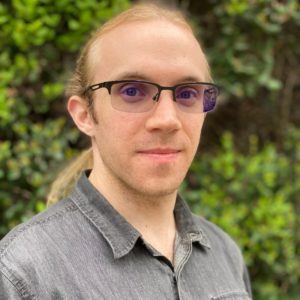Dr. Adam Klein is a neuroscientist who joined Gilgamesh Pharmaceuticals as a Senior Scientist in October 2020. Gilgamesh creates what it calls “new chemical entities” (NCEs), inspired by psychedelics, from which psychotropic treatment of mental health conditions can be developed. Products in Gilgamesh’s pipeline include a “better ketamine” whose anxiolytic and antidepressant benefits are delivered without causing dissociation, a serotonergic micro-dose medication with low abuse potential, and a new ibogaine analog that reduces users’ need for ongoing therapy.
Prior to joining Gilgamesh, Dr. Klein spent two years conducting postdoctoral research as a Fellow in Dr. Adam Halberstadt’s lab at the University of California San Diego (UCSD). He earned his PhD in behavioral neuroscience at the University of California Santa Barbara in 2018 following five years of graduate research in the behavioral pharmacology lab.
Dr. Klein received his Bachelor’s degree in Psychology in 2013 from the City College of New York.
While at Dr. Halberstadt’s lab at UCSD, Dr. Klein studied the neurobiology of psychedelics including LSD, psilocybin, and DMT. Specifically, he helped to elucidate the signaling pathways responsible for these substances’ hallucinogenic effects. He was the lead author of a study describing how 4-substituted tryptamines — certain types of psilocybin analogs — interact with 5-HT2 serotonin receptors.1 He also supported a study led by Dr. Alexander Sherwood that investigated the psychoactive properties of natural tryptamine derivatives of psilocybin mushrooms.2 Psychedelic Science Review covered the research team’s finding that baeocystin is not psychoactive.
Other research by Dr. Klein has:
- Identified a strong correlation between hallucinogenic effects in mouse head-twitch response (HTR) results and their reported potencies in humans and rats.3
- Built evidence for the role of the 1-acyl-substituted lysergamides ALD-52, 1P-LSD, and 1B-LSD as prodrugs of LSD.4
- Characterized 1CP-LSD and its potential LSD-like effects on humans.5
- Identified the relevance of the 2,5-Dimethoxy motif — a common structure in phenethylamine psychedelics — for receptor binding and potency.6
In March 2019, Dr. Klein gave a presentation at UCSB entitled Decoding the Neuropharmacology of Hallucinogenic Drugs at the Serotonin 5-HT2A Receptor. He has also lent his expertise to RGX Medical as a volunteer working on drug use harm reduction efforts at music festivals.
More information on Dr. Klein’s work can be found on his ResearchGate profile.
